Search
Search for "click":
(Click here to search this entire website for "click" with Google.)
 |

|
|
Matrix click is a mikroBUS add-on board with two 5x7 matrices driven by two MAX7219 8-bit LED Display Drivers. The active area of each matrix is 7.62mm high and 5.08 mm wide. 7x5 is a standard resolution for displaying ASCII characters, so the click is essentially a dual-character display capable of showing letters in more readable typefaces compared to a 14-segment display. The click communicates with the target MCU through the mikroBUS SPI interface with two separate Chip Select lines for each matrix (CSL for the left, CSR for the right). This board is designed to use a 5V power supply. |
|
|
|
 |
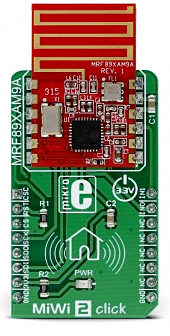
|
|
MiWi 2 click is a sub-gigahertz radio transceiver click board™, which offers a reliable FSK or OOK communication solution, with the maximum data rates of 200kbps and 40kbps, respectively. The radio transceiver module used on this click board™ has plenty of features that make it a perfect choice for compact designs: It has very good reception sensitivity, an onboard PCB antenna, high level of components integration, built in packet handling routines with automatic CRC generation, 64 bytes of transmit/receive FIFO buffer, built in Sync Word recognition, clock/data synchronisation and recovery and many more.
Armed with such a powerful, compact and fully configurable radio transceiver module, MiWi 2 click offers highly reliable radio communication over a short distance, which can be utilized in many applications. It can be used for developing home/industrial/building automation applications, data loggers, applications for remote keyless access, alarms, wireless remote control and a wide variety of similar short-range radio applications. |
|
|
|
 |

|
|
NB IoT click is a Click board™ that allows LTE Cat NB1 connectivity by utilizing Quectel BC95-G, a specialized multi-band IoT module with very low power requirements and compact form factor, making it perfectly suited for various IoT-based applications. This module is an embedded IoT communication solution which supports several NB frequency bands, offering an alternative to similar Low Power Wide Area Network (LPWAN) solutions, such as those offered by Sigfox and LoRa. Its most important advantage is the ability to use already widely established cellular network infrastructures. These features make the NB IoT click a perfect choice for a wide range of IoT applications such as smart metering, bike sharing, smart parking, smart city, security and asset tracking, home appliances, agricultural and environmental monitoring, and more.
Note: To ensure the best performance, please use an antenna that supports frequency bands used by the Quectel BC95-G module
It comes in the package which also includes the mikroSDK™ software and a library with all the functions. The Click board™ comes as a fully tested and approved prototype, making it a reliable device ready to use on the development board.
|
|
|
|
 |
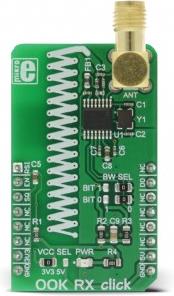
|
|
OOK RX click is a wireless receiver that operates at the frequency of 433MHz (sub-GHz). This device allows realization of a simple, low-speed wireless ad hoc communication network between a receiver and compatible transmitter. This device features an ASK/OOK demodulator, analog RSSI output, and integrated squelch capabilities.
This kind of networking is widely used for remote low-speed communication, such as the remote keyless access, remote fan or light control, garage or gate doors control, unidirectional low data rate wireless links and similar applications where this kind of communication is applicable. |
|
|
|
 |
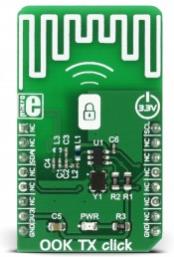
|
|
OOK TX click is a simple wireless transmitter that operates at the frequency of 433MHz (sub-GHz). This device allows realization of a simple, low-speed wireless ad-hoc communication network between a transmitter and compatible receiver, such as the OOK RX click. This device features a programmable transmit power in 1dB steps, On-Off Keying (OOK) modulation with power ramp-up control, and it complies with US (FCC) and Canada (IC) standards.
This kind of networking is widely used for remote low-speed communication, such as the remote keyless access, remote fan or light control, garage or gate doors control, unidirectional low data rate wireless links and similar applications where this kind of communication is applicable. |
|
|
|
 |
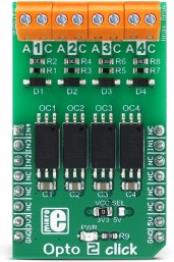
|
|
Opto 2 click is an optical isolator used to provide an optical galvanic isolation of sensitive lines. The used optoisolation elements require very low input current to be driven, down to 1.3mA (min). The speed of the internal optocoupler elements of the Opto click 2 allows it to work with the signals up to 20MHz. The Opto click 2 can be used to provide a galvanic isolation of the MCU pins, allowing driving by external components, while protecting it from surges up to 5kV on the driver side. |
|
|
|
 |

|
|
Opto 3 click is a relay Click board™, equipped with two pairs of optically isolated solid-state relays (SSR). One pair of SSRs is used to provide a reinforced galvanic isolation for the external signals used to drive the microcontroller (MCU) pins, while the other pair of SSRs is used to allow the host MCU to drive some external equipment, allowing up to 40V between the SSR contacts in OFF state, and currents up to 2A while in ON state, thanks to a very low ON-state resistance. Opto 3 click to be used in applications that require reinforced galvanic isolation for both their input and output stages.
Opto 3 click is supported by a mikroSDK compliant library, which includes functions that simplify software development. This Click board™ comes as a fully tested product, ready to be used on a system equipped with the mikroBUS™ socket.
|
|
|
|
 |
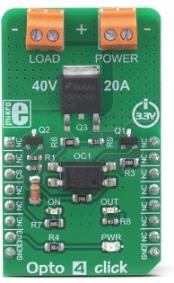
|
|
Opto 4 click is a galvanically isolated power switch, which uses a power MOSFET in combination with an optocoupler. The power MOSFET can withstand significant current due to its low ON resistance, allowing this Click board™ to be used with different kinds of power demanding applications. In addition, this Click board™ is equipped with the voltage limiting circuit, which cuts off the power supply when the voltage of the externally connected power supply suddenly drops. The galvanic isolation of the optocoupler offers protection of the controller circuit, thus preventing power surges from the controlled circuit.
Opto 4 click is supported by a mikroSDK compliant library, which includes functions that simplify software development. This Click board™ comes as a fully tested product, ready to be used on a system equipped with the mikroBUS™ socket.
|
|
|
|
 |

|
|
RTC 10 Click is a real-time clock module which has an extremely low power consumption, allowing it to be used with a single button cell battery, for an extended period of time. It features the DS3231M, a low-cost, extremely accurate, I2C real-time clock (RTC) from Maxim Integrated. The device incorporates a battery input and maintains accurate timekeeping when main power to the device is interrupted. The integration of the microelectromechanical systems (MEMS) resonator enhances the long-term accuracy of the device and reduces the piecepart count in a manufacturing line.
RTC 10 click is supported by a mikroSDK compliant library, which includes functions that simplify software development. This Click board™ comes as a fully tested product, ready to be used on a system equipped with the mikroBUS™ socket.
|
|
|
|
 |
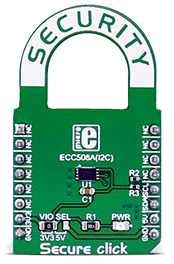
|
|
Secure click carries the ATECC508A cryptographic coprocessor with secure hardware-based key storage. The click is designed to run on either 3.3V or 5V power supply. It communicates with the target microcontroller over I2C interface. |
|
|
|
 |
|
<< First
< Previous
Next >
|
|

